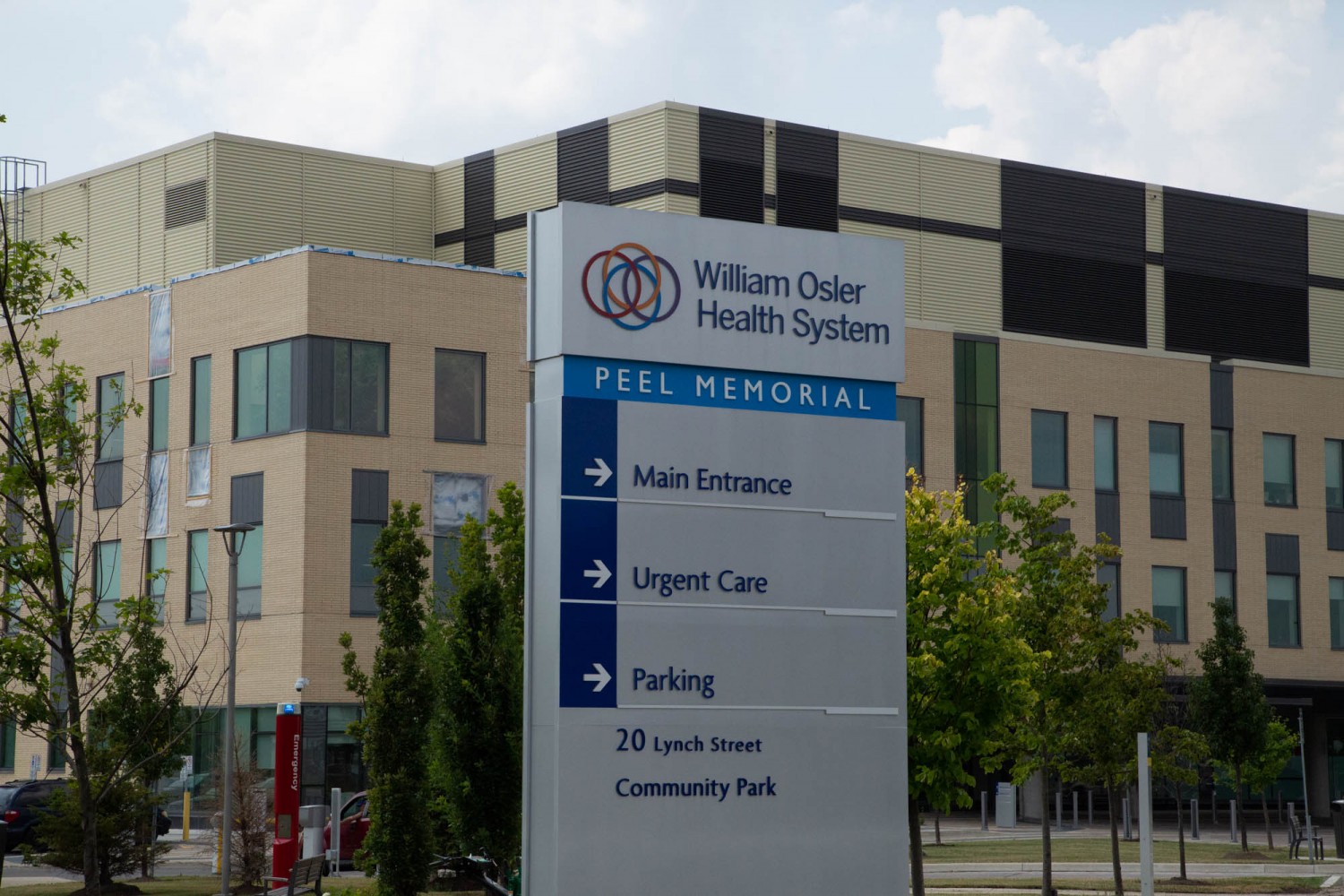
While anger mounts over Brampton’s healthcare crisis Osler again delays proposal for Peel Memorial expansion
As Bramptonians continue to languish in hospital hallways and are left waiting hours for care in the city’s sole full-service emergency department, the William Osler Health System has yet to submit its proposal for Phase-2 expansion of Peel Memorial to the province, despite earlier assurances it would be handed over by the end of January.
In a taped interview, Dr. Naveed Mohammad, executive vice president, quality, medical and academic affairs at William Osler Health System told The Pointer there is no hard deadline for the submission to the province. Instead, Osler and the Ministry of Health are having regular conversations about the project. “There are many moving parts and many moving discussions on a daily basis that are really gaining some momentum and I think we’re going to have a good proposal to submit in the near future.”
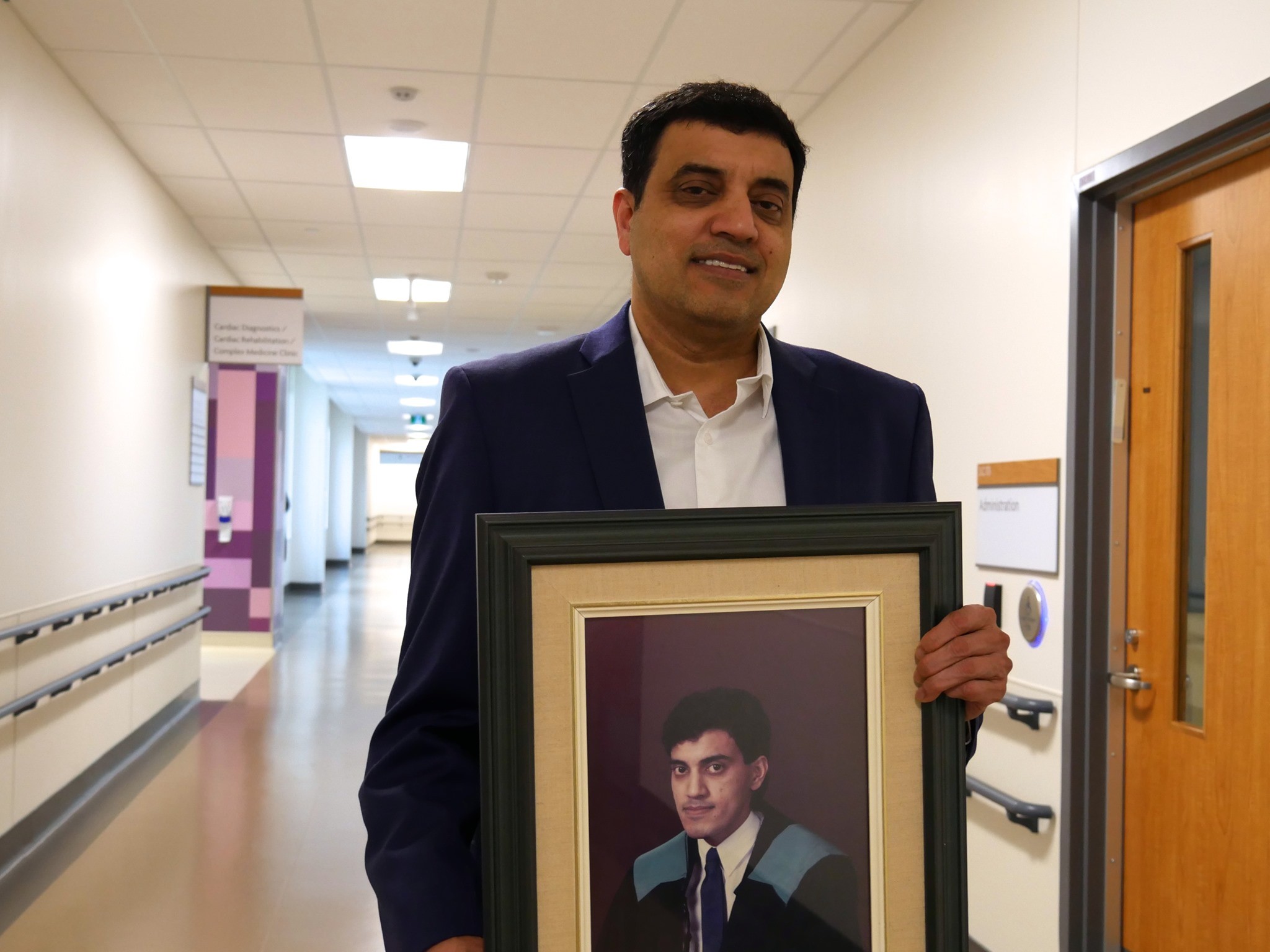
Dr. Naveed Mohammad stands with his university graduation photo
Previously, Osler told The Pointer the proposal for Phase II would be submitted at the end of January. Now, according to Dr. Mohammad, these timelines are unclear.
This follows a response from the province to The Pointer last year, revealing it expected the proposal back in the fall. Under the previous Liberal government, Osler was given $500,000 two years ago to create the proposal. It’s unclear why the process in Osler’s hands has been delayed.
Members of the public have also voiced frustration that they have not been consulted by Osler for the plan, considering the health system relies on Brampton residents and taxpayers to help raise funds for local projects. City taxpayers have already contributed $20 million for the phase-2 expansion through a levy, with the money losing value the longer the project is delayed.
Initially Dr. Mohammad said “it’s going to be a few more days,” when asked about submission for the crucial proposal. Later in the interview, he said community engagement for the project will proceed through the winter and spring of 2020 to ensure a solid proposal is developed that addresses all community needs so that another plan won’t be required in the short-term.
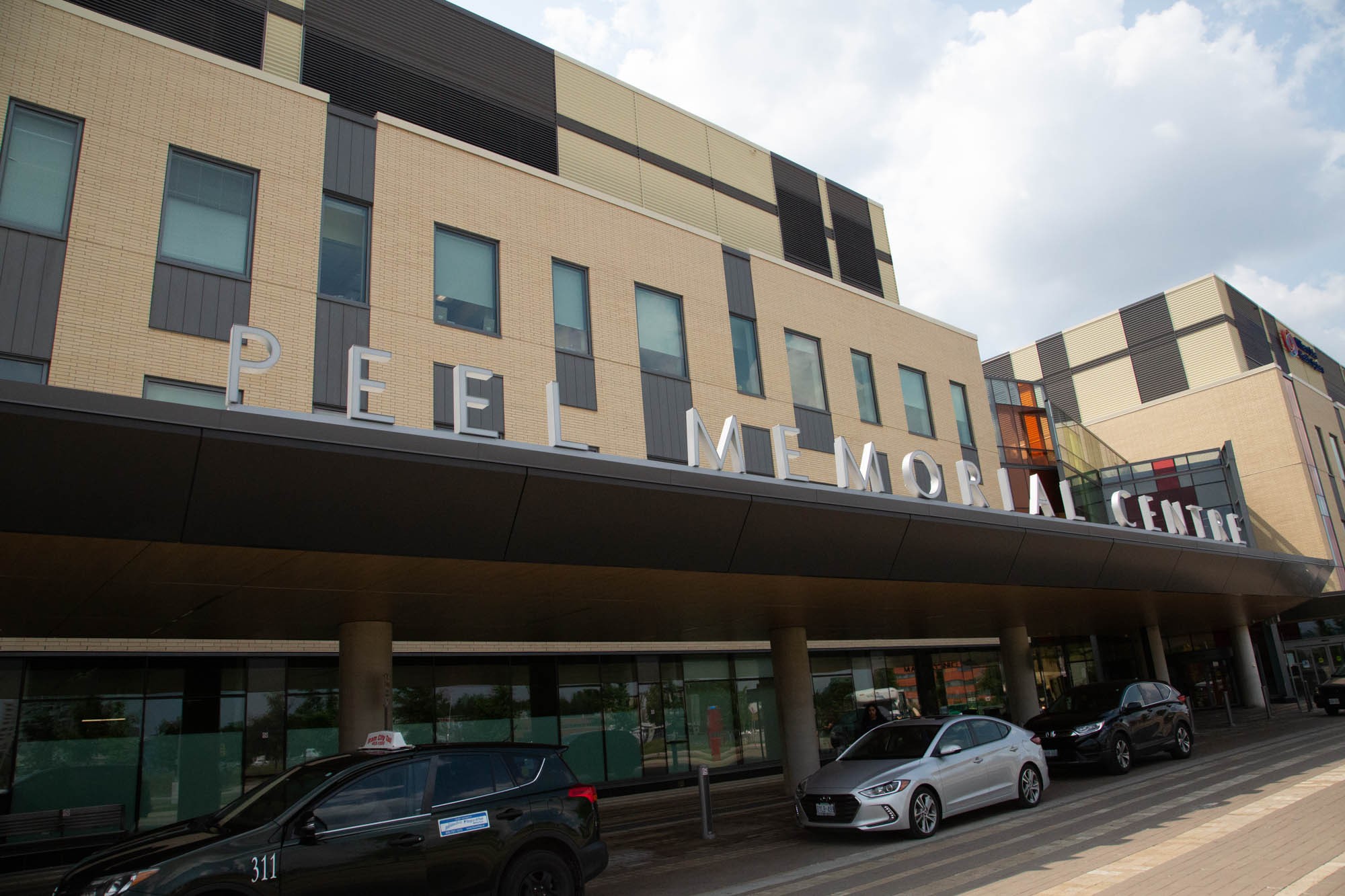
“We understand the community’s frustration with Brampton’s current capacity challenges,” Dr. Mohammad said. He added that if a proposal is submitted in the near future, the shortest period of time to get things up and running for the new hospital expansion is between four and five years. Osler previously told The Pointer it would take between five and eight years for Peel Memorial Phase II to open its doors.
Despite calls by city leaders and community advocates for an additional 850 acute care hospital beds, to get Brampton up to the provincial average, as part of the Phase-2 expansion of Peel Memorial, there remains uncertainty around the number of beds Memorial will receive under the much anticipated proposal.
Currently Brampton has less than half the number of hospital beds per capita compared to the provincial average and just one third compared to the national average.
Dr. Mohammad said additional beds will be part of the proposal, but he’s not sure what the final number will be as it depends on several factors, including the size of the overall downtown property and the capacity of traffic that's allowed in the area, just east of the city centre.
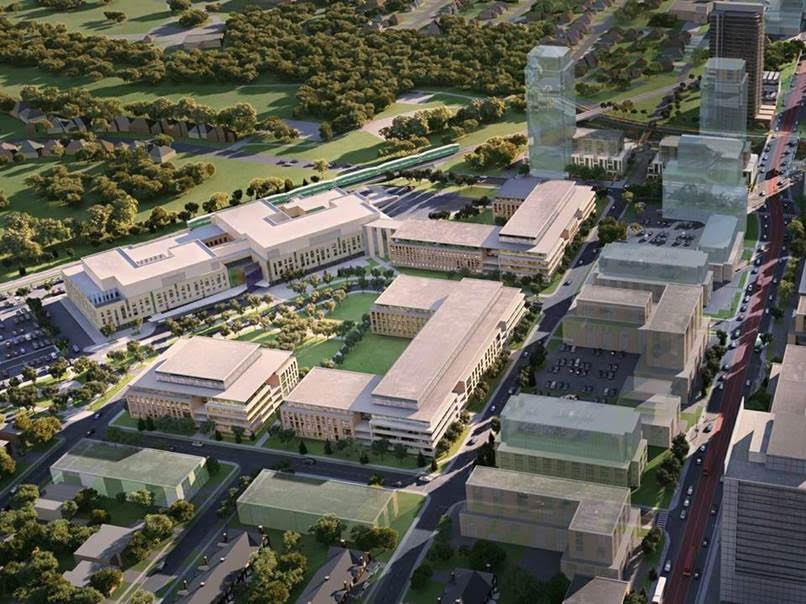
An early rendering of the phased build-out for Peel Memorial.
“There’s a lot of moving parts that we as healthcare professionals need to take advice from engineers, from traffic planners, from city planners.” He said there will not be 850 beds when the Peel Memorial expansion first opens. “It’s just almost impossible to get that many beds in that location but that doesn't mean we’re not going to ask for it in stages.”
The lack of available beds in Brampton is placing significant pressure on the local healthcare system. As of November 2019, the average wait time for someone who visits the emergency room (ER) at Brampton Civic and gets admitted to the hospital is 19.7 hours. This figure includes any time patients spend getting access to a bed, but that is often not a proper bed, because of constant overcrowding that forces patients to wait on gurneys in hallways and other makeshift spaces.
The provincial target for people to be admitted to the hospital from the ER is 8 hours. In 2019, only 24 percent of patients received by Brampton Civic were admitted in this timeframe. In comparison, admission time is between 3.8 and 4.6 hours at the top five performing hospitals in Ontario. This means the majority of patients who walk through the doors of Brampton Civic’s ER spend four to five times longer waiting for admission compared to the best performing hospitals and two-and-a-half times longer than the provincial target.
These egregious wait times have forced local residents to look elsewhere for the care they need.
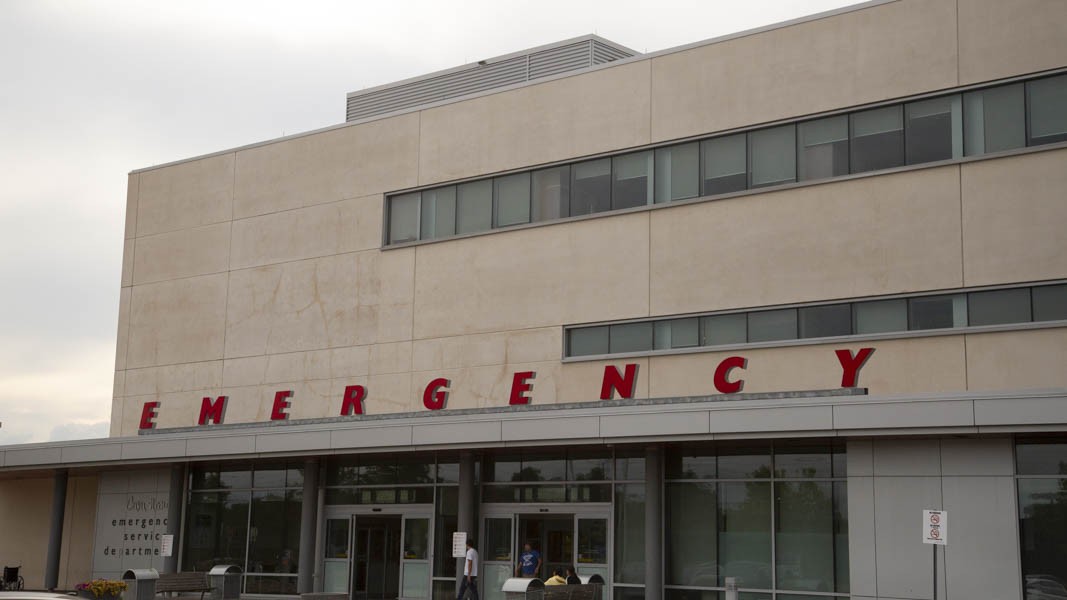
When Mark McDonald’s wife had a health issue, the couple decided that Brampton Civic Hospital was not where they were headed.
“Our choice was not to go to Brampton Civic, we went to Credit Valley [instead]. Not because of the quality of the care but simply because of the overcrowding and long wait times that we knew we would expect,” the Brampton resident told The Pointer.
Dr. Mohammad said the organization feels the pain of the communities it serves. As an emergency physician, treatment in hallways is not ideal. “I don't like to go in a hallway and ask a patient that I want to examine their leg, I’m just as concerned about it as our deserving patients are.”
The expansion of Peel Memorial has long been seen as a partial solution to these troubles. Dr. Mohammad said Osler will focus on services and programs to assist mental health concerns in the community along with senior care and occupational therapy. It’s unclear if the urgent care facility will be expanded and if acute care beds will be introduced, with the appropriate treatment facilities to assist patients suffering a variety of conditions.
Brampton Civic is currently the only full service hospital in the city. Peel Memorial has an urgent care department, which isn’t meant for many types of emergencies. It will look at broken bones, minor burns and infections, but if the situation is a more severe emergency, individuals must get to the ER at Brampton Civic for conditions including seizures, major trauma, mental health issues and internal bleeding.
Dr. Mohammad questions the notion that Brampton Civic is the only hospital in Brampton, stating it’s about where patients can receive the best service, as a hospital is not always the answer.
“The key is to have a community that has enough services and enough capacity in the community so people don't have to come to the hospital,” he told The Pointer. In his eyes, Brampton Civic, Etobicoke General, Peel Memorial, its expansion, and Ontario Health Teams can together help the community access medical assistance, without making a hospital their only option. However, he said it would be at least a year before new health teams announced under the PC government are implemented. Ontario Health Teams will include healthcare professionals that provide care to patients outside of a hospital setting. Dr. Mohammad said a year is not long as “healthcare requires a significant amount of planning, a significant amount of IT, a significant amount of resources.” Until the teams are launched, the only place to access immediate emergency care is at Brampton Civic, which has been running over capacity for several years.
According to information obtained through a Freedom of Information request by the NDP in 2019, Brampton Civic operated between 101 percent and 106 percent capacity that year, far over the recommended 85 percent. Peel Memorial was operating at 557 percent capacity in 2019, and saw an increase to 587 between April and June 2019. Brampton Civic is treating more people than it can handle, and patients often end up in hallways waiting to get access to a bed. In 2018, 3,035 patients were treated in the hallways of Brampton Civic. Comparatively, in 2012, the number of patients treated in hallways was 1,014. Brampton Civic currently has 635 beds funded by the province and Peel Memorial has no outpatient beds. In Brampton, there is less than one bed for every 1,000 residents. The provincial average is 2.3 hospital beds for every 1,000 residents.
In 2017/18 the Central West Local Health Integration Network (CW LHIN) received $936 of overall funding per person while the provincial average sat at $1,907. The network monitors local healthcare systems in various regions, including Brampton.
Last month, the dire situation in Brampton led local councillors to declare a healthcare emergency. Council voted on a number of measures that must be looked at to ensure the crisis is properly addressed. One of these actions ordered the Chief Administrative Officer (CAO) David Barrick to work with the William Osler Health System, and the provincial and federal governments to provide urgent funding for resources for front line workers at Brampton Civic and Peel Memorial so they can operate fully staffed. Dr. Mohammad said Brampton’s healthcare crisis has been building up for years and isn’t something that happened over night. He said the mayor’s office, city council, Osler and the Ministry of Health are working closely together on solutions.
The local contribution — dollars which will need to come from the municipality and Osler — sits at approximately 20 percent, including 10 percent of capital construction costs as well as things like furnishings, and specialized equipment that is not covered by the province.
“The ministry will fund 90% of the eligible construction/capital costs and 100% of eligible planning, design, financing and transaction costs. Funding of both the remaining 10% of all eligible project costs and any costs not eligible for ministry funding are the financial responsibility of the hospital,” says David Jensen, a spokesperson for the Ministry of Health.
“The costs for which a hospital is responsible are otherwise known as the local share and can fluctuate from project-to-project depending on the scope. Where a hospital chooses to add non-sharable costs, the local share will increase accordingly. Municipalities may choose to support hospitals by contributing to the hospital’s local share; however, there is no set guideline on how much a municipality is expected to contribute.”
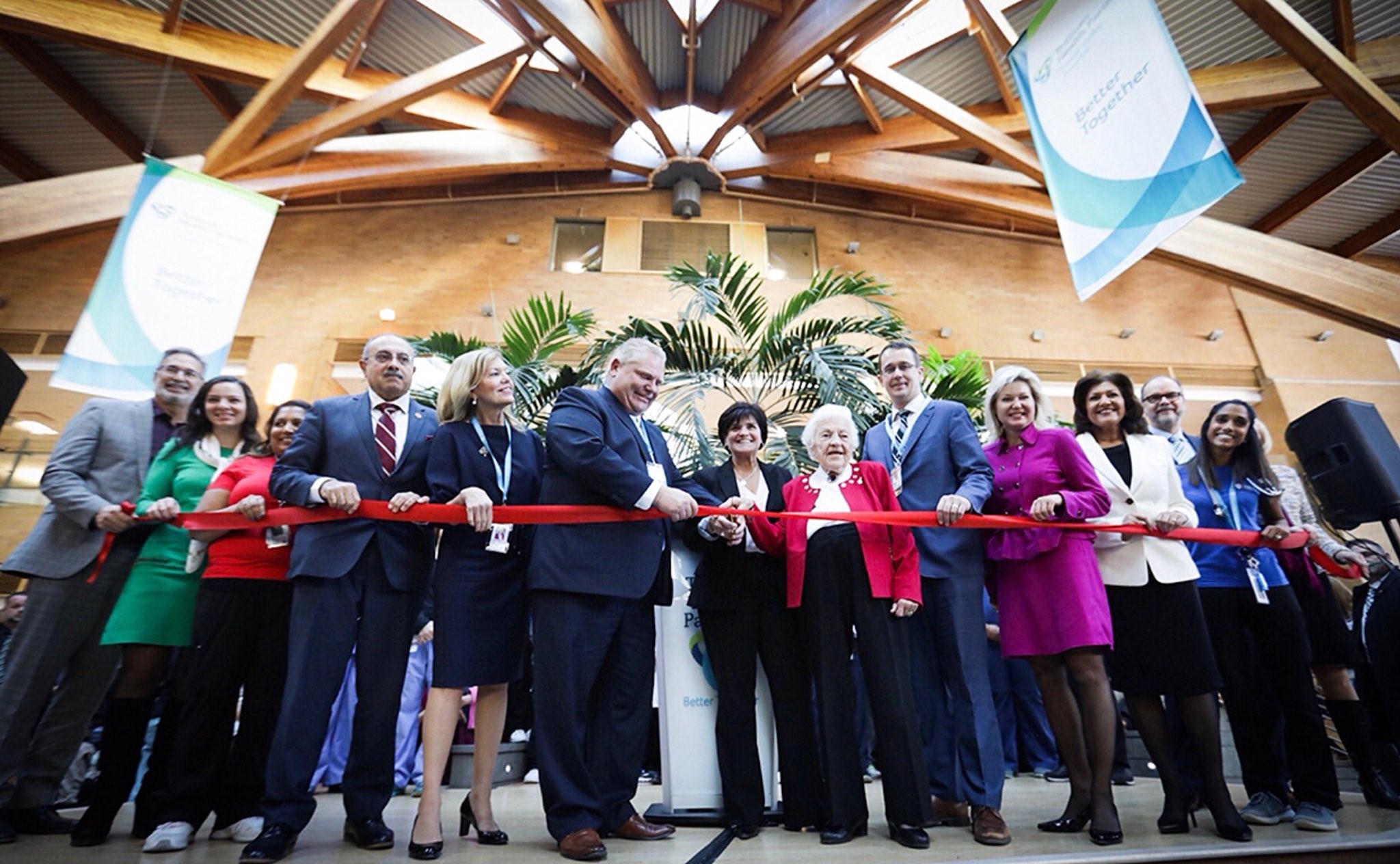
Premier Doug Ford at a celebration for Credit Valley Hospital's expansion opening in 2018
“An approximate range of local share is 20%, however, as a result of commercial sensitivities we are not in a position to disclose specific examples,” he added.
While Brampton’s healthcare system remains one of the lowest funded in the province, the PC government has provided small amounts of relief through various grant programs. The province has previously boasted that the William Osler Health System received $1.5 million through the 2018-19 Health Infrastructure Renewal Fund for Brampton. However, Dr. Mohammad says those funds from the province were dedicated for Osler’s Etobicoke hospital (Etobicoke General), not Brampton Civic or Peel Memorial.
This seems to be disputed by the province, which has stated the $1.5 million went to Brampton.
Dr. Mohammad said it was Osler that directed these funds to Etobicoke General “I don't know what the ministry told you, they may have told you that $1.5 million was for Osler...Etobicoke [General] is a part of Osler,” he said.
“None of that funding from the province was directed towards Peel Memorial or Brampton Civic.”
It remains unclear whether Osler made the decision to put this funding toward its Etobicoke hospital, despite Brampton’s dire need, or if it was stipulated under the terms of the grant from the province, despite its official statement to The Pointer.
Dr. Mohammad said there were other funds that came to Osler and were given to facilities in Brampton. Details around the allocation of these funds weren’t available to him at the time of the interview.
Email: [email protected]
Twitter: @nida_zafar
Tel: 416-890-7643
Submit a correction about this story


